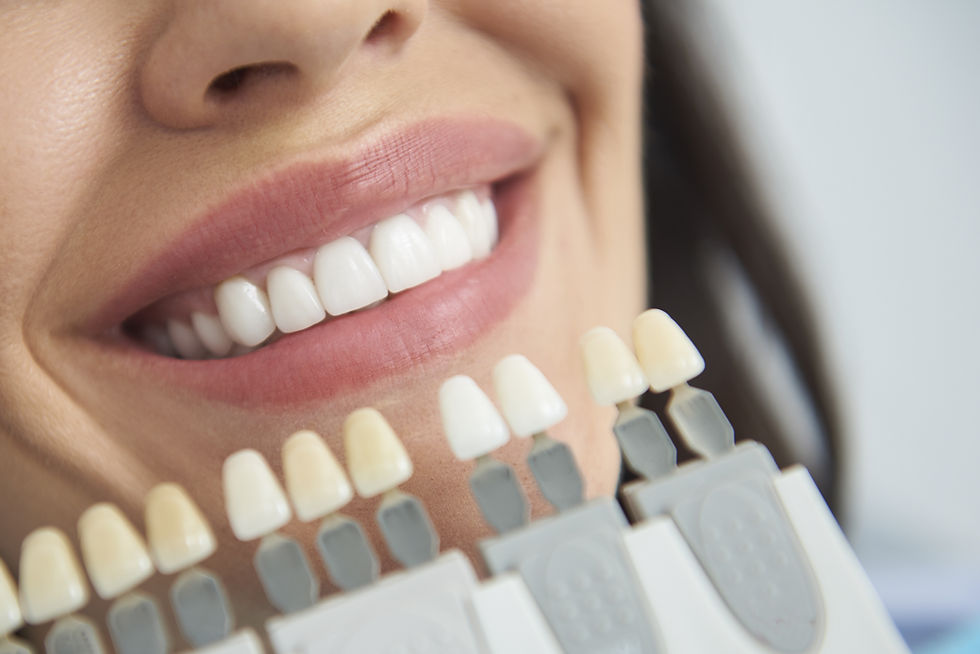From Flaws to Fabulous: What you need to know about Composite Bonding
- Andrew Jowett
- Apr 7, 2024
- 4 min read
Updated: May 4, 2024

Q: What is composite bonding?
A: Composite bonding is a popular cosmetic dental procedure that involves the application of a tooth-coloured resin material to improve the appearance of teeth. Composite bonding typically requires minimal alteration of the natural tooth structure, making it a conservative option for enhancing smiles.
Q: Who is a suitable candidate for composite bonding?
A: Ideal candidates for composite bonding are individuals with minor imperfections in their teeth, such as small chips, gaps, or discolouration. However, it's essential to consult with a dentist to determine suitability, as composite bonding may not be suitable for everyone. Factors such as the overall oral health, bite alignment, and the extent of the aesthetic concerns will influence candidacy.
Q: What factors should patients consider before opting for composite bonding?
A: Patients should be aware that composite bonding is not a reversible procedure. While the resin material can be shaped and polished to achieve desired results, it's important to understand that alterations to the natural tooth structure are involved. Additionally, patients should be committed to maintaining good oral hygiene habits and attending regular dental check-ups to ensure the longevity of the bonded restorations.
Q: Are there any limitations or risks associated with composite bonding?
A: While composite bonding can produce excellent aesthetic results, there are some limitations to consider. The material used in bonding may be prone to staining over time, especially if patients consume foods and beverages that can discolour teeth. Additionally, bonding may not be as durable as other restorative options like veneers or crowns, and may require periodic touch-ups or replacement.
Q: How can patients manage their expectations regarding the outcomes of composite bonding?
A: It's crucial for patients to have realistic expectations about the results of composite bonding, especially in today's age of social media where edited and filtered images can create unrealistic standards. While composite bonding can significantly improve the appearance of teeth, it may not be able to address more complex issues such as severe misalignment or significant gaps. Patients should openly communicate with their dentist about their goals and concerns to ensure that they have a clear understanding of what can be achieved through the procedure.
By understanding the prerequisites and considerations for composite bonding, patients can make informed decisions about their dental care and achieve satisfying results. If you're considering composite bonding, schedule a consultation with your dentist to discuss your options and determine the best course of action for enhancing your smile.
Remember, your dental health is an investment in your overall well-being, so prioritise regular dental visits and maintenance to keep your smile shining bright!
Q: What are some alternative treatment options to composite bonding, and how do they compare?
A: While composite bonding is a popular choice for minor aesthetic improvements, it's essential to consider alternative options, such as porcelain veneers. Let's delve into the differences between these two treatments:
Composite Bonding:
Material: Composite bonding utilises a tooth-coloured resin material that is applied directly to the tooth surface.
Conservatism: This procedure involves minimal alteration of the natural tooth structure, making it a conservative option for cosmetic enhancements.
Cost: Generally, composite bonding is more cost-effective compared to veneers in the short term.
Durability: While durable, composite bonding may be more prone to staining and chipping over time compared to veneers.
Porcelain Veneers:
Material: Veneers are thin, custom-made shells crafted from porcelain that are bonded to the front surface of the teeth.
Aesthetics: Veneers can effectively address more significant cosmetic concerns, such as severe discolouration, extensive chipping, or gaps between teeth.
Longevity: Porcelain veneers typically offer greater longevity and resistance to staining compared to composite bonding.
Preparation: The placement of veneers requires the removal of a small amount of enamel from the tooth surface to accommodate the restorations.
Q: How do patients decide between composite bonding and veneers?
A: The decision between composite bonding and veneers depends on several factors, including the severity of the aesthetic concerns, budget considerations, and personal preferences. While composite bonding is ideal for minor imperfections and offers a more conservative approach, veneers are better suited for more extensive smile makeovers and provide superior durability and stain resistance.
Q: What should patients discuss with their dentist when considering alternative treatment options?
A: Patients should have an open dialogue with their dentist to discuss their goals, concerns, and budget constraints. Dentists can provide personalised recommendations based on the patient's unique needs and help them understand the pros and cons of each treatment option. Additionally, dentists can showcase before-and-after photos or use digital smile simulations to give patients a visual representation of the potential outcomes of composite bonding and veneers.
Q: Are there any considerations for maintenance and aftercare with veneers?
A: While veneers offer excellent durability and resistance to staining, patients should still practice good oral hygiene habits and avoid habits that can compromise the integrity of the restorations, such as chewing on hard objects or using teeth as tools. Regular dental check-ups and professional cleanings are essential for monitoring the health of the veneers and ensuring their longevity.




Comments